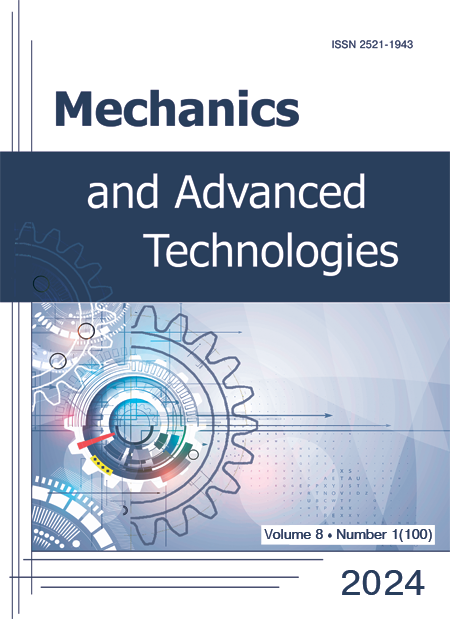Research on Ultrasonic Cavitation Treatment of Milk. An Experimental Approach
DOI:
https://doi.org/10.20535/2521-1943.2024.8.1(100).298105Keywords:
Homogenization, ultrasound, cavitation, fat globules, temperature, intensity, cavitation bubble, collapse energyAbstract
Homogenization is a standard milk processing method used to stabilize fat emulsions against gravitational separation. In the dairy industry, high-pressure homogenization is commonly applied, which requires significant energy input to achieve optimal processing conditions. The size and composition of fat globule membranes affect the sensory and rheological properties of secondary dairy products [1]. Recently, ultrasound has been frequently used for milk homogenization [2]. Unlike ultrasound, mechanical mixing does not provide emulsion stability even after prolonged treatment, highlighting the differences between these two technologies. These differences arise due to the varying degrees of fat globule and membrane disruption. However, dairy products with different physicochemical and functional properties can be produced using both ultrasonic treatment and in combination with other traditional homogenization methods.
To study the impact of ultrasonic treatment parameters of milk, specifically their different values, on the size of fat inclusions and the stability of milk emulsion over a certain period after treatment.
The study employed an experimental method of milk processing using an ultrasonic cavitation unit.
The impact of ultrasonic cavitation on the quality of milk homogenization in a steady volume was investigated. Optimal process parameters, specifically the power of the ultrasonic field and treatment time, were experimentally determined. The use of ultrasonic frequency greater than 33 kHz was found to be impractical.
It was experimentally proven that ultrasonic cavitation treatment of milk is extremely effective for obtaining homogeneous emulsions. Given that excessive heating (> 65 °C) is undesirable in the production of dairy products from a technological standpoint, a definite advantage of this method is the low-temperature (50 °C) mode compared to traditional processing methods (75–80 °C), which also positively affects the preservation of nutrients.
References
- Y. H. Cho, J. A. Lucey and H. Singh, “Rheological properties of acid milk gels as affected by the nature of the fat globule surface material and heat treatment of milk”, Int Dairy J., vol. 9, no. 8, pp. 537–545, 1999. DOI: https://doi.org/10.1016/S0958-6946(99)00123-5.
- M. F. Ertugay, M. Şengül and M. Şengül, “Effect of ultrasound treatment on milk homogenization and particle size distribution of fat”, Turkish J Vet Anim Sci, vol. 28, no. 2, pp. 303–308, 2004. Available: https://journals.tubitak.gov.tr/veterinary/vol28/iss2/9.
- J. P. Canselier, H. Delmas, A. M. Wilhelm and B. Abismaïl, “Ultrasound Emulsification – An Overview”, Journal of Dispersion Science and Technology, vol. 23, no. 1–3, pp. 333–349, 2002. DOI: https://doi.org/10.1080/01932690208984209.
- Z. Zhi, R. Liu, W. Wang, K. Dewettinck and F. Van Bockstaele, “Recent progress in oil-in-water-in-oil (O/W/O) double emulsions”, Crit Rev Food Sci Nutr., vol. 63, no. 23, pp. 6196–6207, 2023. DOI: https://doi.org/10.1080/10408398.2022.2029346.

- N. Vankova, S. Tcholakova, N. D. Denkov, I. B. Ivanov, V. D. Vulchev and T. Danner, “Emulsification in turbulent flow 1. Mean and maximum drop diameter in inertial and viscous regimes”, J ColloidInt Sci., vol. 312, no. 2, pp. 363–380, 2007. DOI: https://doi.org/10.1016/j.jcis.2007.03.059.

- A. Shanmugam and M. Ashokkumar, “Ultrasonic preparation of stable flax seed oil emulsions in dairy systems – physicochemical characterization”, Food Hydrocolloids, vol. 39, pp. 151–162, 2014. DOI: https://doi.org/10.1016/j.foodhyd.2014.01.006.
- Т. Huppertz, Homogenization of Milk | Other Types of Homogenizer (High–Speed Mixing, Ultrasonics, Microfluidizers, Membrane Emulsification), in Encyclopedia of Dairy Sciences (Second Edition). San Diego: Academic Press, 2011, pp. 761–764. DOI: https://doi.org/10.1016/B978-0-12-374407-4.00226-0.
- A. A. Novosad, “Osoblyvosti zastosuvannia ultrazvukovykh rezonansnykh piezoelektrychnykh pryvodiv-vyprominiuvachiv v systemakh mekhatroniky”, Bulletin of the National Technical University of Ukraine "Kyiv Polytechnic Institute", no. 49. pp. 203-211, 2012.
- K. O. Samoichuk, O. O. Kovalev and A. O. Ivzhenko, “Analysis of methods of estimation of quality of homogenization of milk”, Proceedings of the Tavri State University of Agrotechnology, vol. 4, no. 12, 2012. Available: http://elar.tsatu.edu.ua/handle/123456789/873.
Downloads
Published
How to Cite
Issue
Section
License
Copyright (c) 2024 Олександр Луговський

This work is licensed under a Creative Commons Attribution 4.0 International License.
Authors who publish with this journal agree to the following terms:
- Authors retain copyright and grant the journal right of first publication with the work simultaneously licensed under CC BY 4.0 that allows others to share the work with an acknowledgement of the work's authorship and initial publication in this journal.
- Authors are able to enter into separate, additional contractual arrangements for the non-exclusive distribution of the journal's published version of the work (e.g., post it to an institutional repository or publish it in a book), with an acknowledgement of its initial publication in this journal.
- Authors are permitted and encouraged to post their work online (e.g., in institutional repositories or on their website) prior to and during the submission process, as it can lead to productive exchanges, as well as earlier and greater citation of published work











